Those familiar with Cannondale’s production history will no doubt be aware of the company’s fondness for challenging accepted norms to create novel concept bikes. The most imaginative projects pre-dated the company’s bankruptcy in 2003, so they might have been a luxurious indulgence, but it seems as if Cannondale has always been willing to explore new ideas.
While it is true that most of those projects disappeared without a trace, at least one — the Bad Boy — was a striking success and continues to have a place in Cannondale’s catalogue. Conceived in 1999, the Bad Boy was designed to satisfy the training needs of Cannondale’s MTB racing team, but it also brought fresh capabilities to urban bike design.
Cannondale went on to experiment with the limits of the concept — a fully suspended Bad Boy featured in the catalogue at one point — and while it was easy to dismiss the boundary-breaking design as something of a novelty 15 years ago, it was the forerunner to all of the aggressive disc-equipped flat-bar bikes that dominate urban bike catalogues today.
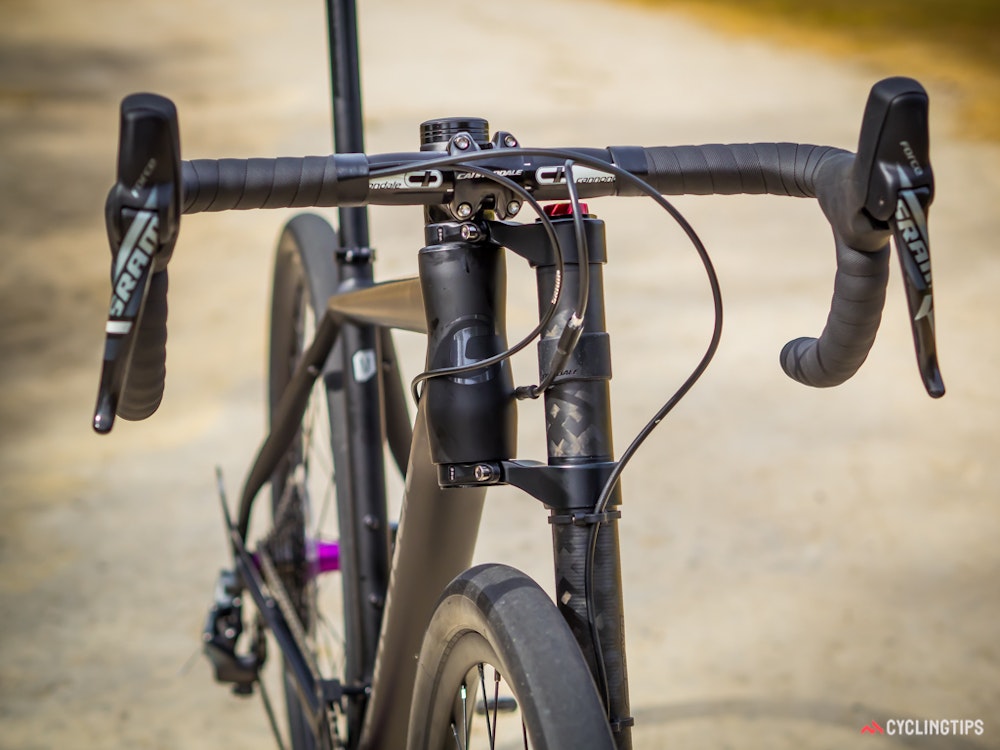
Which brings us to the Slate, a bike that straddles categories just like the Bad Boy did at the turn of the century. Cynics will probably dismiss the concept as a nefarious marketing scheme, while others will wonder why the company bothered after re-creating the Synapse in 2014 to better handle unpaved roads.
According to Cannondale, the Slate isn’t another gravel-grinder; it’s a whole new concept. And to prove it, they’ve created a new category in their catalogue called “New Road” to house the Slate.
If the Bad Boy brought MTB to urban cycling, then the Slate appears intent on doing the same thing for road cycling. It’s a point that wasn’t lost on judges at Eurobike, who handed out one of their Gold design awards for the Slate, commenting: “This new bike by Cannondale combines two worlds that usually have little to do with one another. It echoes elements of a mountain bike and interprets these for road use. As a result, it taps into a bigger target group of cyclists.”
Interestingly, Cannondale’s “New Road” bike rolls on 650b wheels rather than 700c. Cannondale’s reasoning for the smaller wheel size is sound though, since adding a 42mm tyre brings the circumference of the wheels up to match that of a 700c wheel fitted with a 22mm tyre.
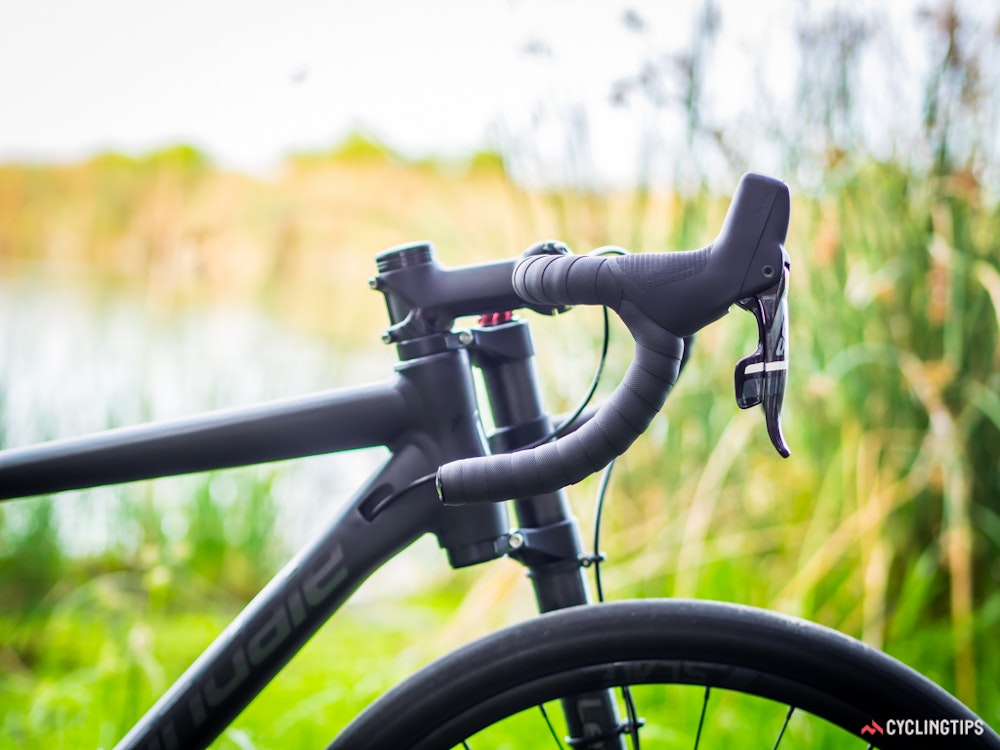
This last point is perhaps the strongest indication that the Slate’s designers never intended for the bike to stray too far from the road category. Indeed, Cannondale’s marketing language categorises the Slate as “a full-tilt road bike with legitimate off-road chops”, “the Swiss-Army knife of road bikes”, and “new where-ever, when-ever, why-ever, on-road, off-road, flat-out ripper road bikes for those with a taste for adventure.”
There are three bikes in the Slate family, starting with the Slate 105 (AU$3,999/US$2,980), followed by the Slate Ultegra (AU$4,899/US$3,520) and at the top of the range there is the Slate Force CX1 (AU$5,899/US$4,260). Each bike features hydraulic disc brakes and 11-speed gearing, however the Slate Force CX1 is the only model with a 1x transmission.
For this review, I spent a few weeks riding a Slate Force CX1 on- and off-road, courtesy of Cannondale’s Australian distributor, Monza Imports.
BEFORE THE RIDE
All of the bikes in the Slate range make use of the same “SmartFormed” 6069 alloy frame and a one-legged suspension fork called Lefty Oliver. The former is an improvement over 6061 alloys in terms of tensile strength and elongation while the latter offers 30mm of travel with adjustable rebound and a lockout function.
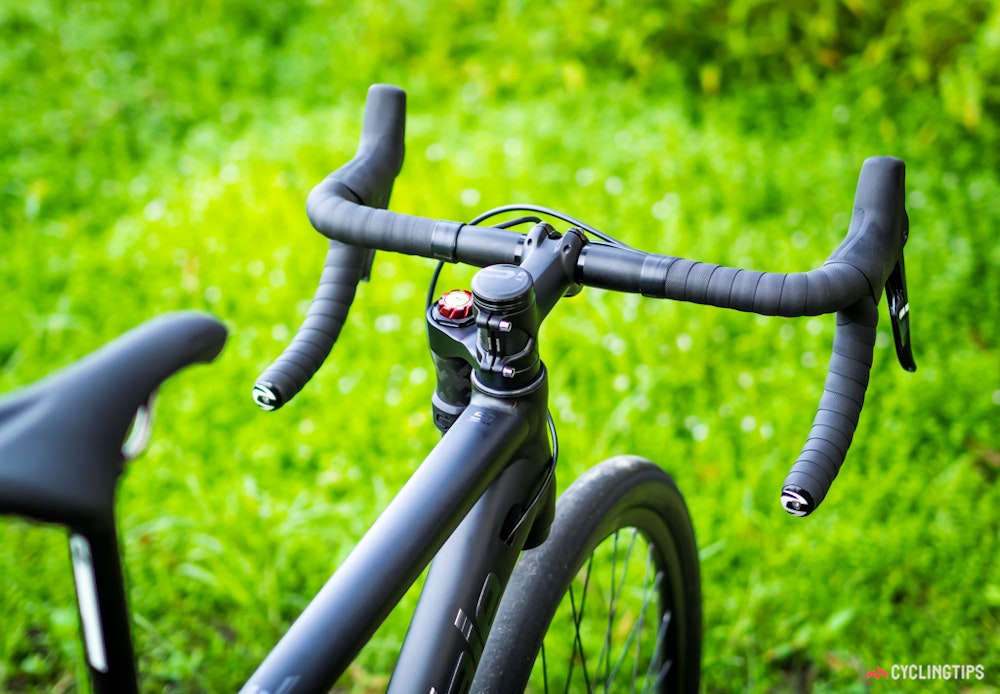
See the red dial on top of the fork leg? That’s where you’ll find the lockout button and rebound adjustment for the Lefty Oliver .
Cannondale started working with 6069 alloy while developing the CAAD10 road frame for 2011. It’s a material that was first described in the late ‘90s and it improves upon the properties of 6061 alloy, especially strength, such that Cannondale was able to save 200g on the final weight of the CAAD10 frame compared to the CAAD9 (and another 50g for the recently released CAAD12).
The relatively new starting material comprises just one aspect of Cannondale’s “SmartFormed” alloy frames. The company makes use of a variety of mechanical processes (e.g. hydroforming, taper butting, mechanical shaping, swaging) and double-pass welding to create the Slate then it uses heat-treatment to maximise the strength and durability of the frame.
The Slate frame makes use of Cannondale’s latest BB30A bottom bracket design, a 27.2mm seatpost diameter, and a 142 x 12mm rear thru-axle that threads into a replaceable rear derailleur hanger. Internal routing is provided for the brake and gear cables and is compatible with electronic groupsets.
The stays of the frame have been designed to bend under load like springs, providing “micro-suspension” for the rear end of the bike. It’s a strategy that Cannondale has been employing since the first version of the Synapse however the amount of “travel” is limited to just a fraction of that offered by the Lefty Oliver fork.
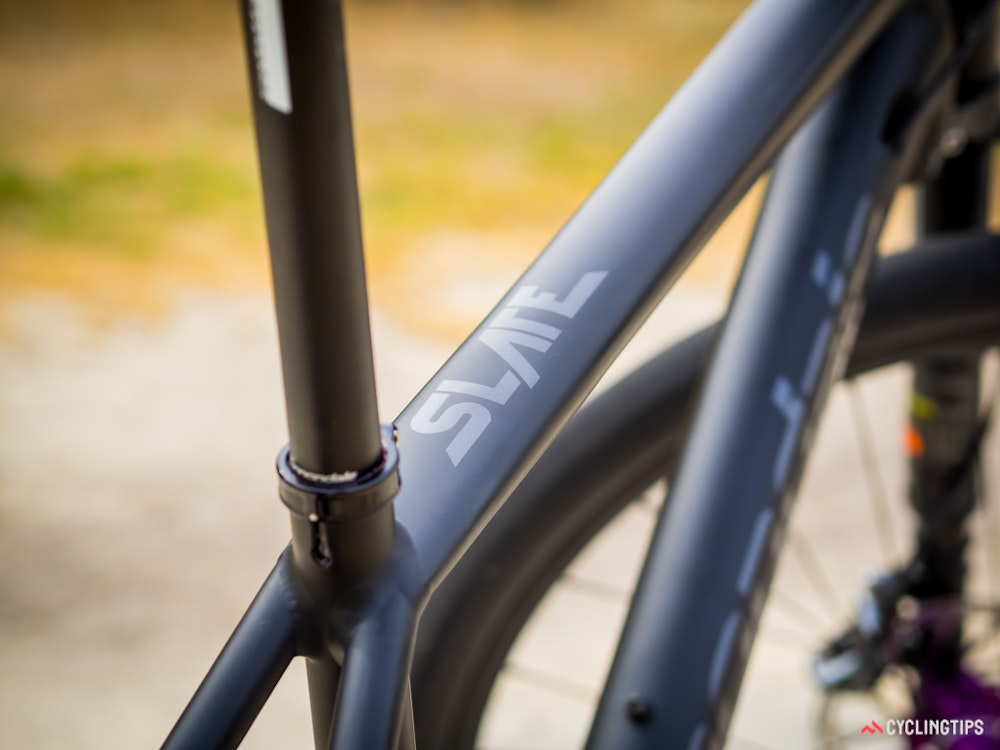
The Slate frame is built from 6069 aluminium alloy, a relatively new formula that is stronger than 6061.
Cannondale introduced its Lefty suspension fork in 2000 and the design has been evolving ever since. According to the company, Lefty is stiffer and lighter than two-legged suspension forks with a smoother action that is less prone to stiction. That’s because the telescoping structure rolls on needle bearings rather than sliding on bushes.
The Lefty Oliver was specifically developed for the Slate, adapting and translating the original Lefty design and technology for the road. To this end, Oliver makes use of slimmer leg diameters to offer 30mm of travel that can be locked-out when desired. And as an air-sprung fork, the Oliver can be adjusted to suit different rider weights.
The Oliver fork demands a variety of proprietary parts, starting with the front hub. The front axle is forged as part of the lower leg assembly and the front hub bearings are pressed into place each time the wheel is bolted on. There is no quick-release mechanism for the wheel, but then, there’s no need to remove the wheel to replace the tyre and/or tube.
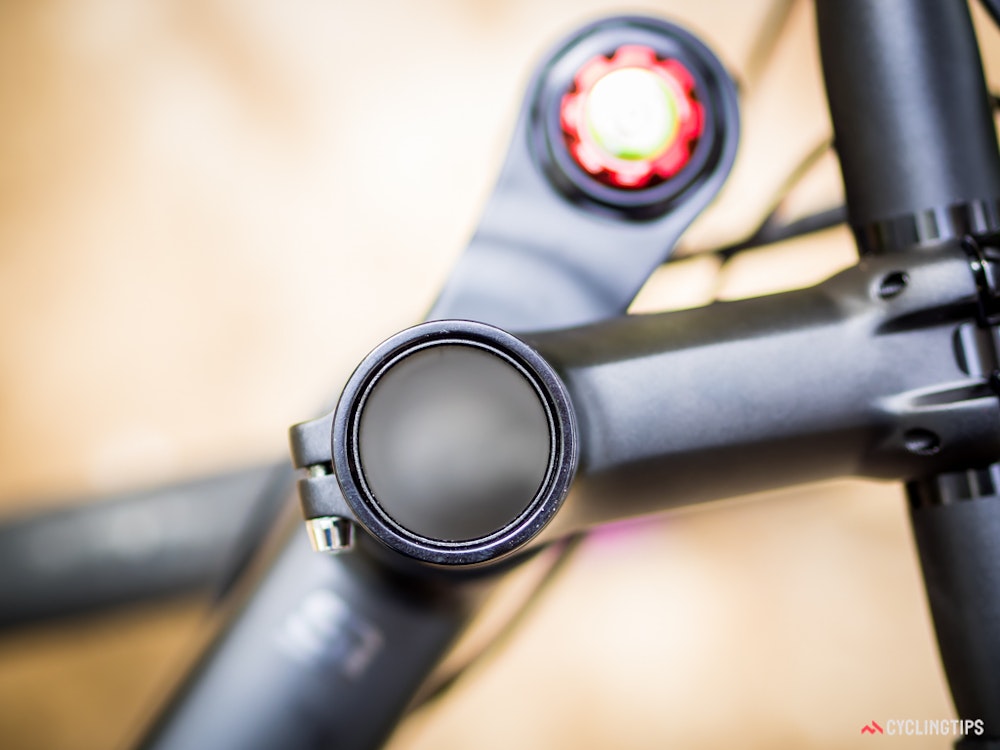
There’s no need for a top cap and bolt for the Lefty Oliver, just a plug to keep the dirt out.
The Oliver has a proprietary dual-crown and steerer design with a precise-fit that demands a specific head tube length, oversized headset bearings, and a unique stem diameter. The steerer is installed from the bottom-up like a giant pin and is secured by clamps in each crown. There is no adjustment for bearing pre-load so the stem simply slides on top of the upper crown with just 12.5mm of spacers for height adjustment.
The unique diameter (nominally 1.5inch) of the steerer means that the only stems that can be used with the Oliver are those made by Cannondale (there are two choices, ±5° or ±20° for lengths 60-120mm). By contrast, there are aftermarket choices for Lefty-compatible front hubs (eg DT Swiss, Industry Nine, Chris King).
Buyers will find that the Slate is offered in four frame sizes, as shown in the chart below:

Overall, the geometry of the Slate tends towards long and upright, however each size is supplied with a 100mm stem that moderates the overall reach. Fork rake (45mm) and chainstay length (405mm) are uniform for all frame sizes while bottom bracket drop ranges 70-65mm (decreasing as the frame size increases). For a detailed geometry chart, see Cannondale.
I found myself caught in between sizes for the Slate, so opted for a smaller bike in a size medium. I was able to get close to my ideal road-fit but really needed a longer seatpost and stem to optimise my position. Regardless, the smaller fit proved to be an asset off-road since the bike was more manoeuvrable.
The Slate Force CX1 sent for review featured SRAM’s hydraulic Force CX1 groupset with hydraulic flat-mount disc brakes and a 1x transmission driven by Cannondale’s hollow forged HollowGram Si crankset with a 44T chainring and a 10-42 cassette.
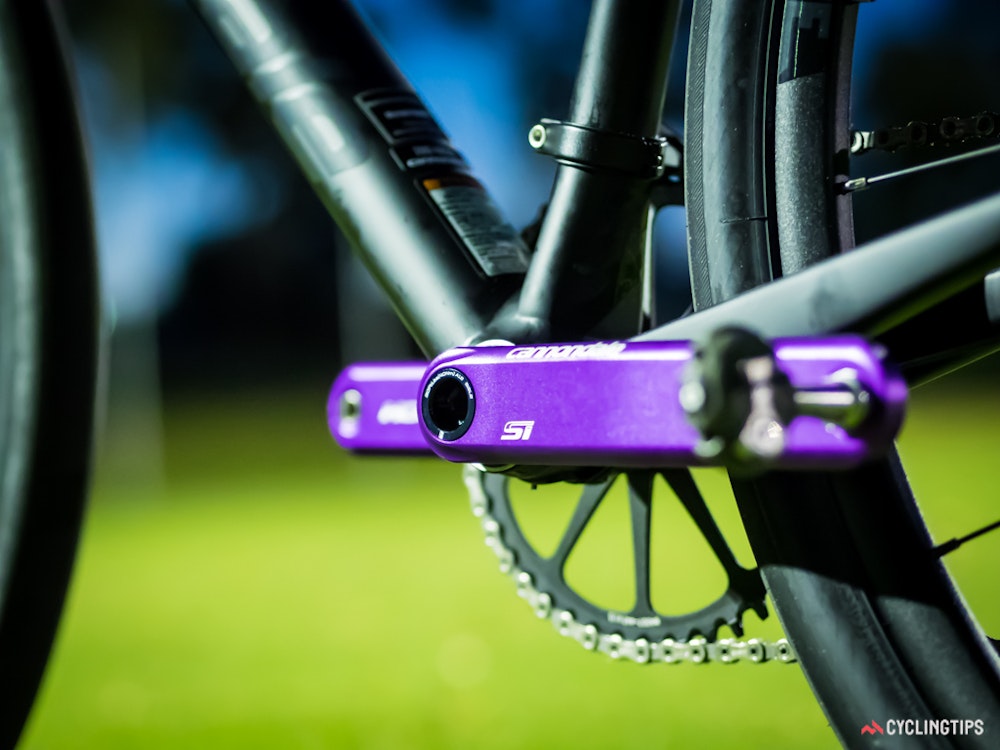
Cannondale also supplied the Slate-branded alloy rims, front hub, seatpost, stem and handlebars. The bike was finished with a rear hub from Formula, tubeless ready Panaracer tyres (650b x 42mm) and a Fabric saddle. The final weight of the bike was 9.20kg sans pedals and bottle cages.
A few notes on assembly and servicing of the bike: owners will need a T-25 Torx key to remove the front disc calliper before the front wheel can be removed with a 5mm Allen key. A chainguide is provided for the front chainring however it can be considered a precaution rather than a necessity. Finally, Cannondale recommends that the Lefty Oliver be serviced after 100 hours of riding.
As mentioned above, the starting price for the Slate is AU$3,999/US$2,980 (Shimano 105 build) and tops out at AU$5,899/US$4,260 for the SRAM Force CX1 build reviewed here. For more information, visit Monza Imports and Cannondale.
AFTER THE RIDE
I enjoy riding my road bike on unpaved roads: the variety in terrain is refreshing and I thrive on the challenge it offers. Tubeless tyres are a necessity (to avoid pinch flats) but that is the only concession I’ve ever made (I don’t even bother with lower tyre pressures).
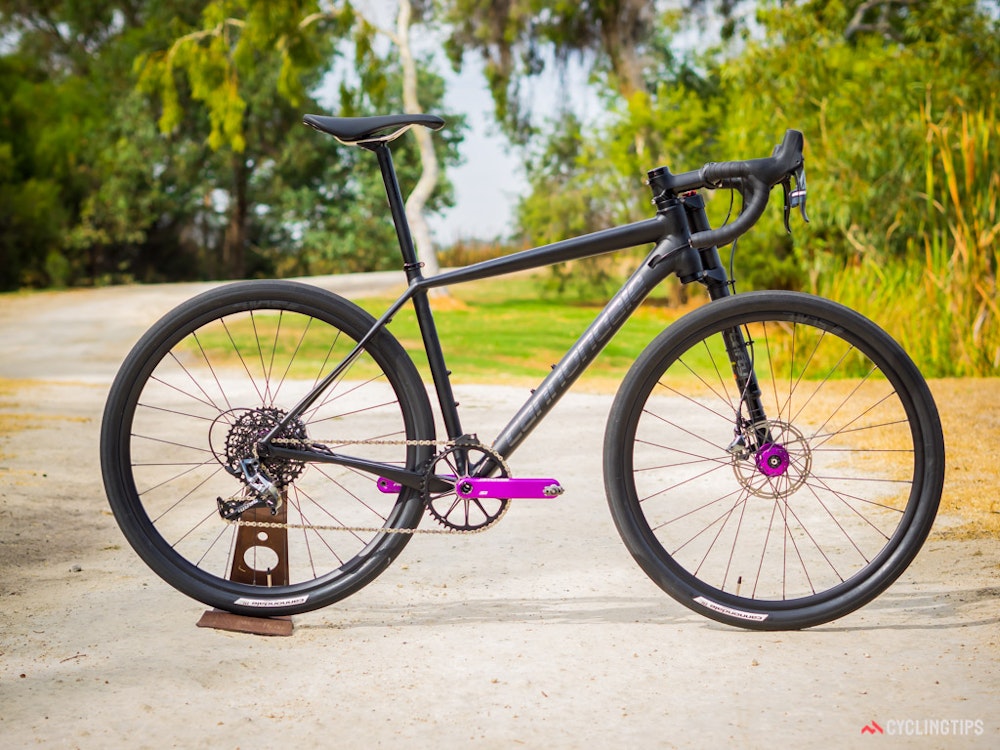
Bicycle Quarterly editor Jan Heine calls this “underbiking” and I like the term, but as he notes, it’s an approach that is ill-suited to long distances. By contrast, a dedicated off-road rig (e.g. a hardtail XC bike) will handle unpaved roads with ease, but most will find these bikes too slow and cumbersome on the road.
Cannondale believes that the Slate offers riders the best of both worlds, which made it difficult for me to decide on a meaningful point of reference. Should I think of the Slate as a road bike that could be used off-road, or, as a dirt bike that can be used on the road? And what about the choice for tyre pressure and suspension settings?
Ultimately, I decided to treat the Slate as if it was a road bike, opting for firm tyres (~45psi) and my usual road pedal and shoe combination (Speedplay and Bont, respectively).
It didn’t take me long to discover that the Slate wasn’t a gifted road bike. The 42mm tyres offered a very plush ride but they were too slow compared to typical road tyres. The extra weight of the Slate was also an immediate handicap, making for a bike that was slower and less responsive than any road bike on the market.
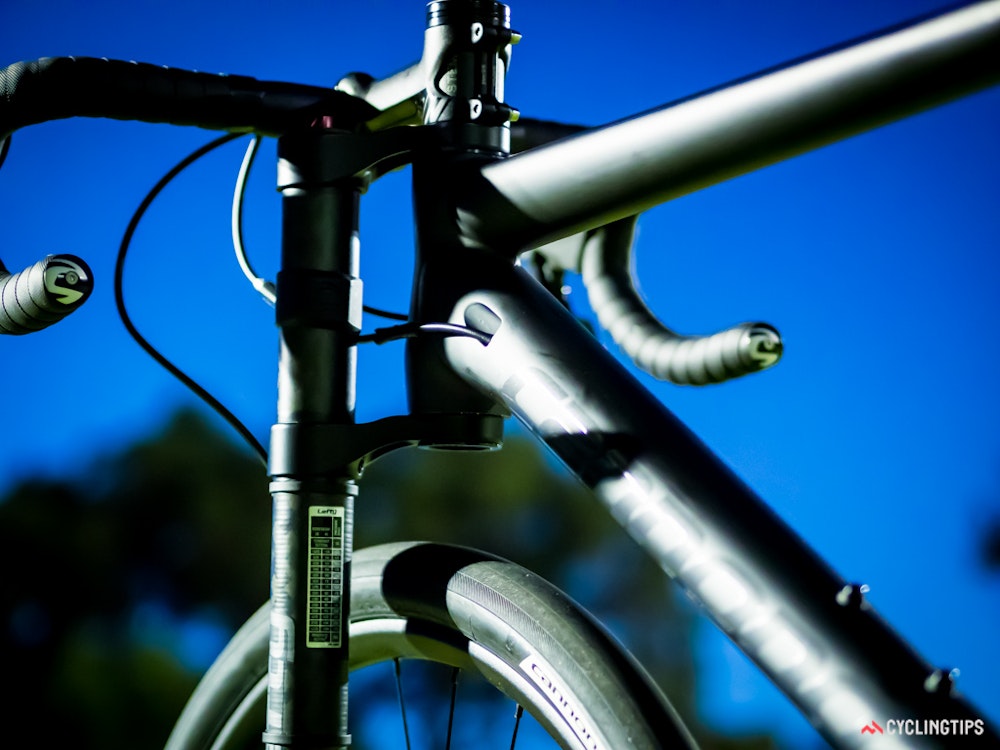
All cables (and wires, if required) are routed internally.
While the tyres were cumbersome, I have to applaud Cannondale’s decision to use 650b wheels. The overall poise and weight distribution of the Slate was immediately familiar with a relatively low centre-of-gravity. The steering was slow though, adding further to the dawdle-like nature of the bike.
The 1x transmission worked quite well on the road, where the lower ratios were a good match for the extra resistance offered by the fat tyres. At times, I could match the pace of my buddies on their road bikes, but ultimately, I lacked the same kind of zippiness that they enjoyed.
I kept the Lefty Oliver locked out for the majority of my road efforts. When I did unlock the suspension, the front end dived around and bobbed far too much, even with maximum rebound damping. Besides, it was completely unnecessary due to the plush tyres, even on the very worst paved roads.
Venturing off-road, I started with the semi-groomed paths/tracks that I’ve ridden with a variety of road bikes, and that was when the Slate started to shine. The 42mm tyres that were so cumbersome on the road now started working in favour of the bike, such that it was more sure-footed and comfortable than a road bike.
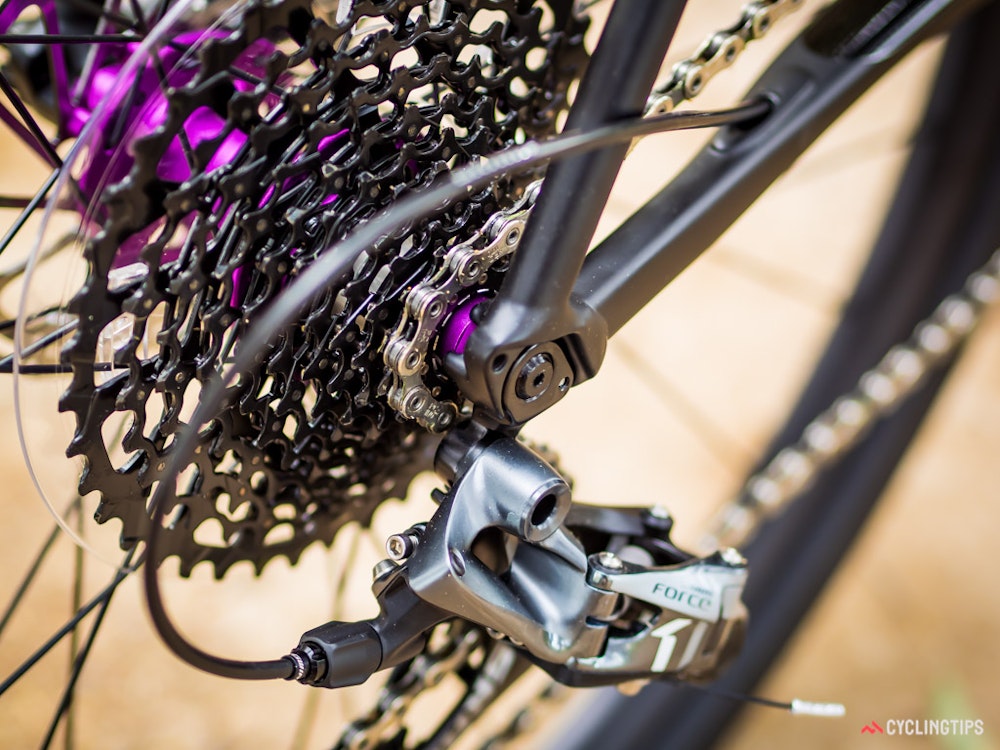
The 1x transmission comprises a 44T chainring and 10-42 cassette.
There was, however, a limit to the amount of grip the tyres offered, especially in the dry and dusty conditions that prevailed for the duration of the review period. I’m sure that letting some air out of the tyres would have improved their grip, but I couldn’t be bothered with inflating them again for the next paved section.
While the grip was vague, the tyres were unfailing in their plushness. And I didn’t suffer any pinch-flats over the course of three weeks despite terrain that would have pinched standard road clinchers many times over. The option to go tubeless is there too, almost straight of the box: the rims are taped and the tyres ready, so all that is needed is a pair of tubeless valve stems and some sealant.
The slow steering and handling of the bike was a much better match for off-road conditions. I found that the smaller frame size also worked to my advantage, adding somewhat to the agility of the bike. Nevertheless, the lack of grip undermined my confidence and I found myself riding unpaved surfaces with much of the same caution and trepidation as I would on a road bike.
I spent a lot of time pondering how much difference the tyres could make to the capabilities of the Slate off-road. However, this is where the 650b wheel size is a definite liability for the bike, since there are just a few different tyre choices on the market at the moment. This is in profound contrast to the plethora of options available for 700c wheels, thanks to the ferocious development of tyres for a wide range of cyclocross conditions.
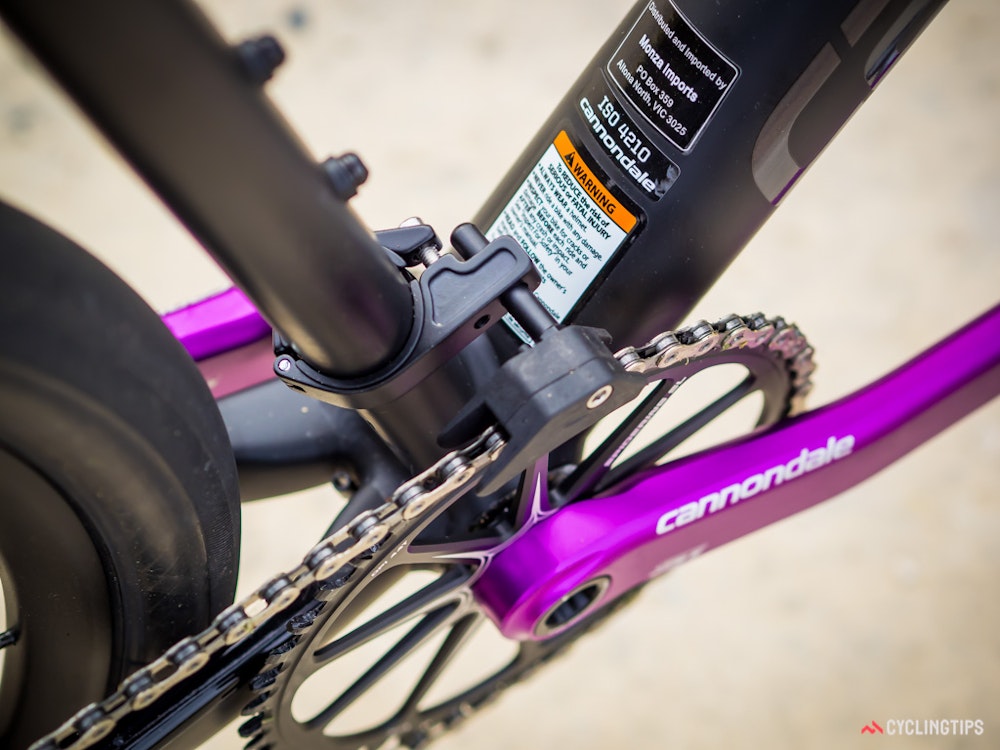
Cannondale supplies a chain guide for the 1x chainring but the combination of the wide-narrow tooth profile and a clutch in the rear derailleur are virtually foolproof.
The 1x transmission was good on the road but even better off-road, where the simplicity of a single shifter and a “sequential gearbox” made the bike easier to ride. SRAM’s robust DoubleTap mechanism also helped, by clearly announcing every shift, both to the hand and the ear.
I found the Slate an able climber that excelled on sharp undulations. The frame and locked-out fork were sturdy enough to channel all my power directly to the wheels, even when some of the short climbs pitched up into ankle-busting double-digit gradients.
The disc brakes were more than capable enough for handling fast, sudden descents, but the drop bars and road levers kept my weight forward when I really wanted to lean back. This is the realm where a dedicated off-road rig with flat bars will always shine. Opting to use the tops of the Slate’s drop bars puts the brake levers out of reach, so there will always be an element of underbiking when riding the Slate off-road.
It wasn’t too difficult to find terrain that was beyond the capabilities of the Slate. For example, some back country “roads” comprising sand and crushed limestone, pockmarked with shallow potholes and littered with rocks defeated the bike, largely because of the limited travel of the Lefty Oliver.
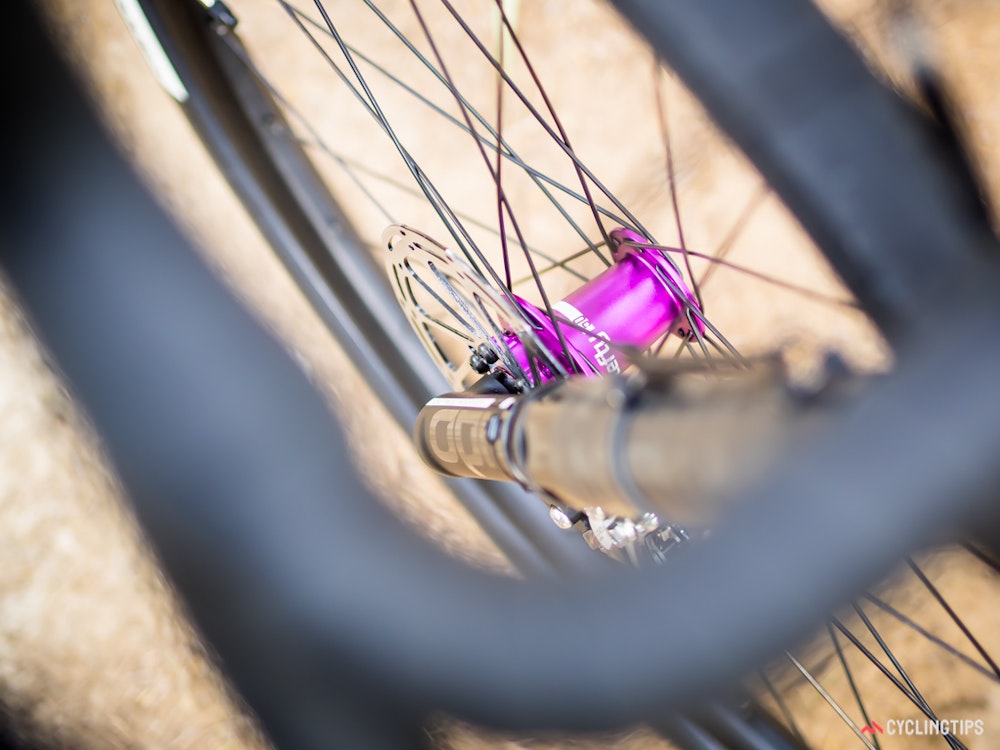
The missing fork leg may worry some but Cannondale’s Lefty design is sturdy and confidence-inspiring.
Locking out the fork proved that it was doing something to smooth out the terrain, but it wasn’t enough. What I really needed was a plusher fork with more travel. Once again, I was underbiking, rattling out of control every time I tried to lift my speed. After an hour on these roads, I was exhausted from the effort of trying to tame the front end.
Interestingly, the rear of the bike seemed to perform better than the front because I never suffered from any soreness. I suspect the 27.2mm seatpost provided a lot of compliance (perhaps more than the engineered stays), but I was also impressed by the amount of comfort Fabric’s Scoop Radius Race saddle had to offer.
By the end of the review period, the Slate needed a good wash, but that was all that was all I had to do to restore it to showroom condition. Three weeks is far too short to judge the durability of any bike, but I’m confident that the Slate Force CX1 will prove to be robust.
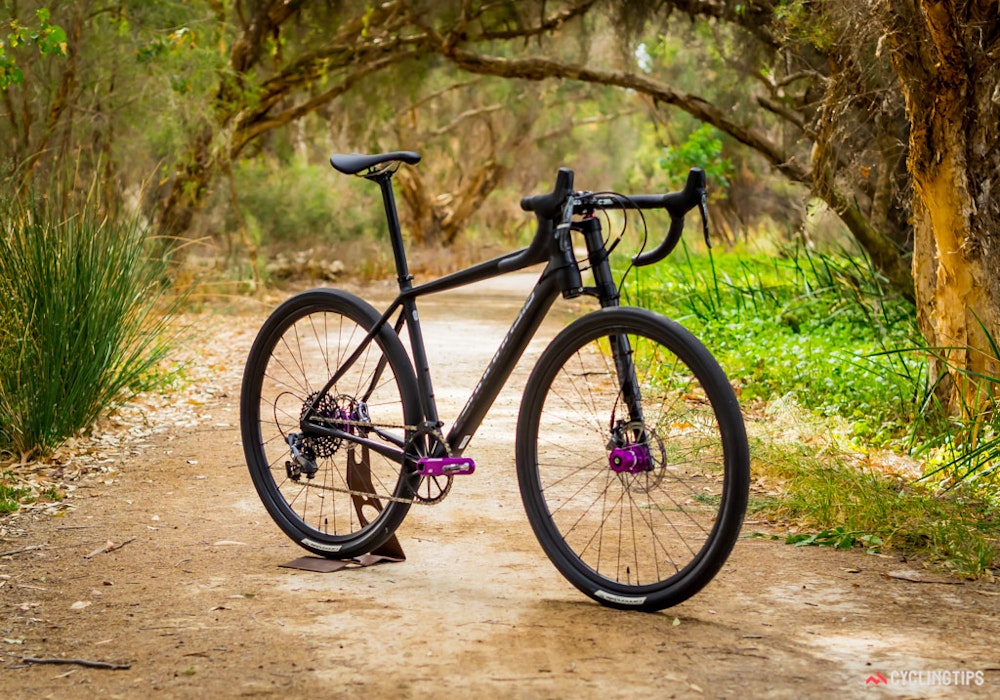
What is less certain is how well the bike will meet the expectations of any buyer. For those riders that would never consider taking a road bike onto unpaved terrain, the Slate may prove to be a playful revelation. On the other hand, road riders that have been getting dirty may find that the bike doesn’t do enough to expand on the capabilities of their current bikes or to compete with lighter cyclocross offerings.
Cannondale promises that the Slate is the Swiss-Army knife of road bikes and I tend to agree; however, none of the blades are especially sharp. Nevertheless, Cannondale have hit their mark with ease, creating a road bike that will contend with unpaved routes with more ease than a conventional road bike.
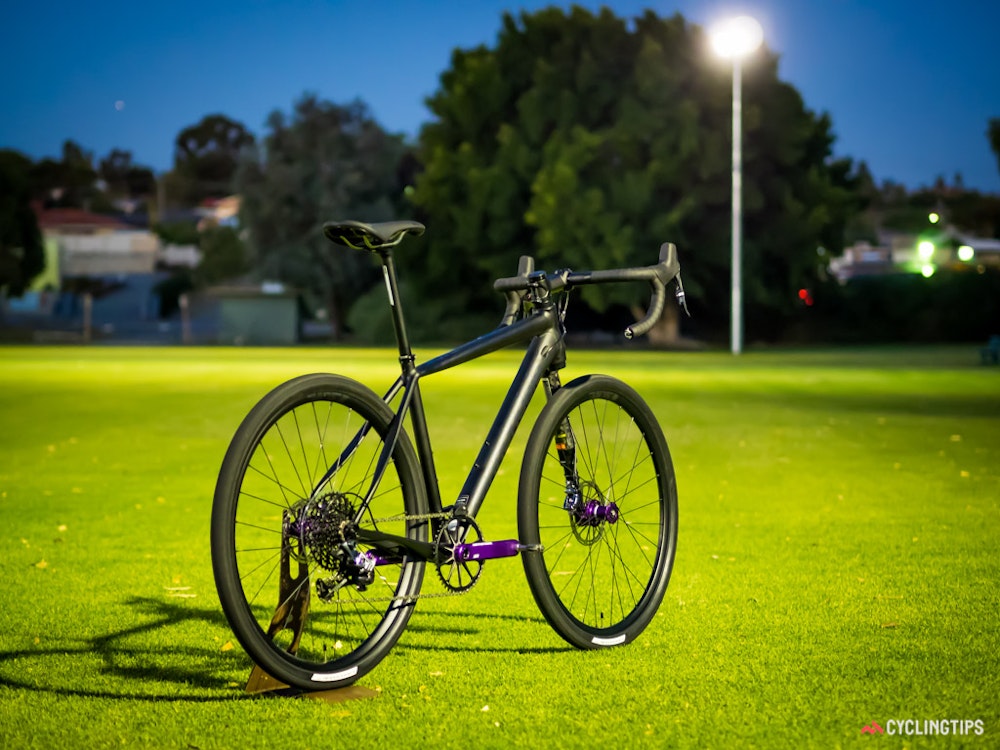
WRAP-UP
NOVELTY?
The Slate borrows from MTB to yield a road bike that can contend with unpaved roads, but whether the bike manages to impress or disappoint will depend upon the expectations of the rider. When judged against a road bike, the Slate is too heavy and slow for road use, yet it’s more agile and faster than a dedicated off-road rig. Away from the road, the Slate struggles with rough terrain and the stock tyres lack grip, but it will take a rider further than most road bikes. Weight, size medium: 9.20kg sans pedals and bidon cages. RRP, AU$5,899/US$4,260.
GOOD STUFF
Handles the transition between road/off-road
650b wheel size with wide tyres work well
1x transmission
Robust build kit
BAD STUFF
Heavy and slow on the road
Fork suspension has limited travel
Tyres lack off-road grip
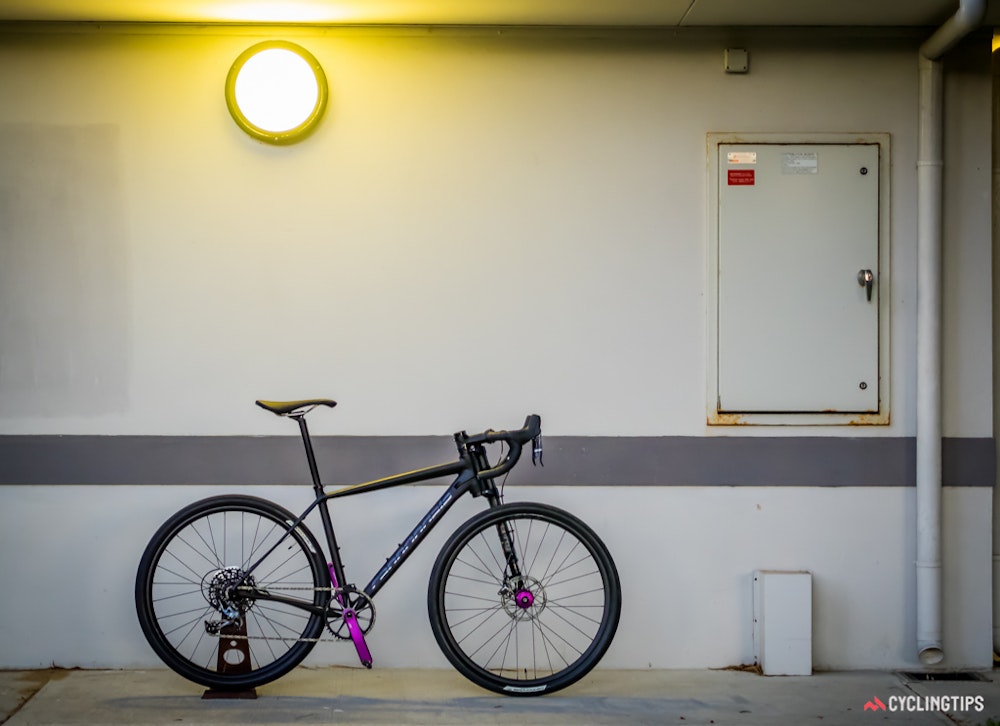
This article was originally published on cyclingtips.com





